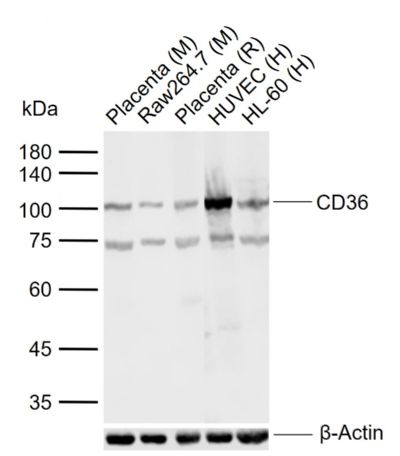
Rabbit Anti-CD36 antibody
Platelet glycoprotein 4; PAS-4; Platelet glycoprotein IV; Glycoprotein IIIb; GPIV; GPIIIB; GP3B; Leukocyte differentiation antigen CD36; PAS IV; Platelet collagen receptor; Fatty acid translocase; FAT; Thrombospondin receptor; CD_antigen: GP4; CD36_HUMAN.
View History [Clear]
Details
Product Name CD36 Chinese Name CD36抗体 Alias Platelet glycoprotein 4; PAS-4; Platelet glycoprotein IV; Glycoprotein IIIb; GPIV; GPIIIB; GP3B; Leukocyte differentiation antigen CD36; PAS IV; Platelet collagen receptor; Fatty acid translocase; FAT; Thrombospondin receptor; CD_antigen: GP4; CD36_HUMAN. literatures Research Area Tumour Cell biology Signal transduction Stem cells Cell Surface Molecule Cell type markers vascular endothelial cell endothelial cells The new supersedes the old Immunogen Species Rabbit Clonality Polyclonal React Species Human, Mouse, (predicted: Rat, Chicken, Horse, Rabbit, Sheep, ) Applications WB=1:500-2000 ELISA=1:5000-10000 IHC-P=1:100-500 IHC-F=1:100-500 IF=1:100-500 (Paraffin sections need antigen repair)
not yet tested in other applications.
optimal dilutions/concentrations should be determined by the end user.Theoretical molecular weight 53kDa Cellular localization The cell membrane Form Liquid Concentration 1mg/ml immunogen KLH conjugated synthetic peptide derived from human CD36/PAS-4: 351-430/472 <Extracellular> Lsotype IgG Purification affinity purified by Protein A Buffer Solution 0.01M TBS(pH7.4) with 1% BSA, 0.03% Proclin300 and 50% Glycerol. Storage Shipped at 4℃. Store at -20 °C for one year. Avoid repeated freeze/thaw cycles. Attention This product as supplied is intended for research use only, not for use in human, therapeutic or diagnostic applications. PubMed PubMed Product Detail The protein encoded by this gene is the fourth major glycoprotein of the platelet surface and serves as a receptor for thrombospondin in platelets and various cell lines. Since thrombospondins are widely distributed proteins involved in a variety of adhesive processes, this protein may have important functions as a cell adhesion molecule. It binds to collagen, thrombospondin, anionic phospholipids and oxidized LDL. It directly mediates cytoadherence of Plasmodium falciparum parasitized erythrocytes and it binds long chain fatty acids and may function in the transport and/or as a regulator of fatty acid transport. Mutations in this gene cause platelet glycoprotein deficiency. Multiple alternatively spliced transcript variants have been found for this gene. [provided by RefSeq, Feb 2014]
Function:
Seems to have numerous potential physiological functions. Binds to collagen, thrombospondin, anionic phospholipids and oxidized LDL. May function as a cell adhesion molecule. Directly mediates cytoadherence of Plasmodium falciparum parasitized erythrocytes. Binds long chain fatty acids and may function in the transport and/or as a regulator of fatty acid transport. Receptor for thombospondins, THBS1 AND THBS2, mediating their antiangiogenic efects.
Subunit:
Interacts with THBS1 and THBS2; the interactions mediate the THBS antiangiogenic activity.
Subcellular Location:
Membrane; Multi-pass membrane protein.
Post-translational modifications:
N-glycosylated and O-glycosylated with a ratio of 2:1.
DISEASE:
Defects in CD36 are the cause of platelet glycoprotein IV deficiency (PG4D)[MIM:608404]; also known as CD36 deficiency. Platelet glycoprotein IV deficiency can be divided into 2 subgroups. The type I phenotype is characterized by platelets and monocytes/macrophages exhibiting complete CD36 deficiency. The type II phenotype lacks the surface expression of CD36 in platelets, but expression in monocytes/macrophages is near normal. Genetic variations in CD36 are associated with susceptibility to coronary heart disease type 7 (CHDS7) [MIM:610938].
Similarity:
Belongs to the CD36 family.
SWISS:
P16671
Gene ID:
948
Database links:Entrez Gene: 948 Human
Entrez Gene: 12491 Mouse
Omim: 173510 Human
SwissProt: P16671 Human
SwissProt: Q08857 Mouse
Unigene: 120949 Human
Unigene: 18628 Mouse
Unigene: 406799 Mouse
Unigene: 102418 Rat
Unigene: 205840 Rat
CD36属一种多功能The cell membrane受体,CD36参与长链脂肪酸的吸附和调节Apoptosis残物的清理和巨噬细胞的吞噬作用, 属于一种抗蛋白酶血小板膜表面glycoprotein。
CD36 广泛在单核细胞、巨噬细胞、内皮层细胞、血小板、红细胞前板、脂肪细胞、肌肉细胞以及乳腺内皮层细胞中有不同的表达。CD36抗原是血小板反应素的配体,两者结合后产生抑制Tumour血管生成的效应。Product Picture
Lane 1: Mouse Placenta tissue lysates
Lane 2: Mouse Raw264.7 cell lysates
Lane 3: Rat Placenta tissue lysates
Lane 4: Human HUVEC cell lysates
Lane 5: Human HL-60 cell lysates
Primary: Anti-CD36 (SL8873R) at 1/1000 dilution
Secondary: IRDye800CW Goat Anti-Rabbit IgG at 1/20000 dilution
Predicted band size: 52 kDa
Observed band size: 100 kDa
References (0)
No References
Bought notes(bought amounts latest0)
No one bought this product
User Comment(Total0User Comment Num)
- No comment



 +86 571 56623320
+86 571 56623320
 +86 18668110335
+86 18668110335

